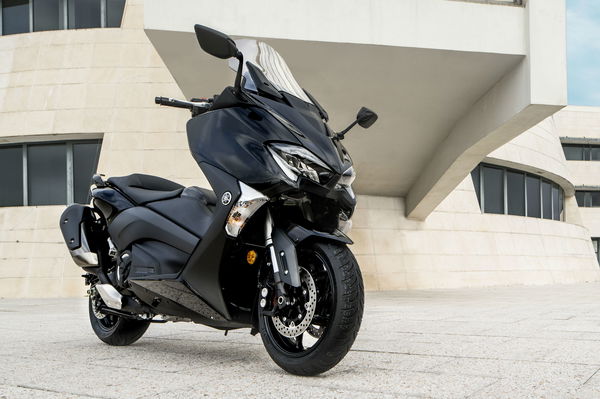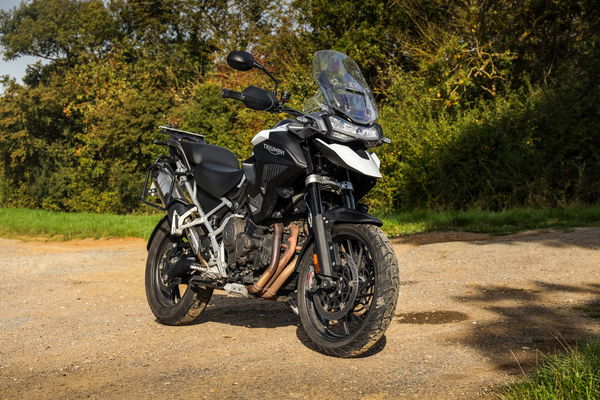Triumph Street Cup vs Ducati Scrambler Café Racer review
Café racers go head-to-head at the Distinguished Gentleman’s Ride
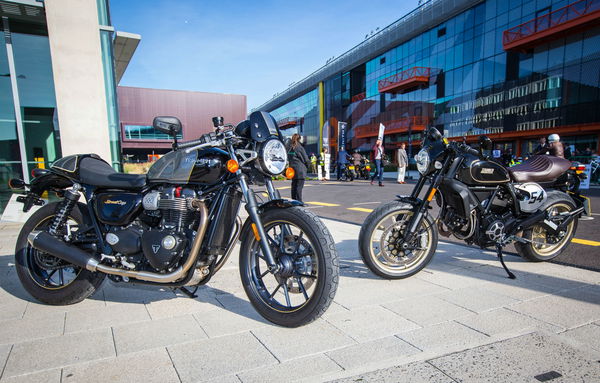
THEY’RE two of the coolest bikes of the year and we’ve just tested them at one of the coolest events in motorcycling.
The bikes are the Triumph Street Cup and Ducati Scrambler Café Racer, two machines so obviously vying for the same customers that a test was obligatory. They’re the café racer versions of the Triumph Street Twin and Ducati Scrambler respectively.
The event is the Distinguished Gentleman’s Ride in London, where everywhere is tweed, moustaches and bowties, and the motorcycles ridden are mix of genuine customised classics and modern models emulating the same style, like the two we’ve turned up on.
About 90,000 motorcyclists took part in DGR rides in major cities across the world on Sunday, raising over £3m for men’s health issues.
That it captures the imagination of so many shows what an important force in motorcycling the so-called ‘new-wave custom’ scene has become.
It’s why we have a whole market of new scramblers, bobbers and café racers like these two. So where better to test them?
Of course, we tested them out of town too. Here’s what we found...

Engine
Immediately on turning the throttles, these two bikes reveal themselves as having taken entirely different approach to the same problem.
You just have to look at the numbers to see why. The Scrambler Café Racer’s makes 49lbft at 5,750rpm and 73hp at 8,250rpm, giving it a strong mid-range followed by a stronger top-end: exactly the characteristics you would expect from a modern 803cc V-twin.
The Triumph Street Cup, on the other hand, makes 59lbft at 3,230rpm and 55hp at 5,900rpm. No, I haven’t got those figures the wrong way round. It makes a very un-modern-like more pounds-feet than horses.
There’s a satisfying dollop of torque at around 3,000rpm, delivering stronger and more addictive acceleration than I had expected from Triumph’s ‘high-torque’ 900cc parallel-twin. But it doesn’t have much more to give over 5,000rpm and the red line is at 6,500.
Despite the Triumph’s greater claimed peak torque, the Ducati feels much more lively from the off, with a more aggressive initial throttle response. Switching from the former to the latter took some mental recalibration to tame the Ducati’s comparative enthusiasm to get going.
Handling
The bikes have little more in common here and again the reasons are apparent on paper.
Unlike most manufacturers, Triumph still doggedly sticks with dry weight figures, and when that still gives the Street Cup a claimed mass of 200kg, we get an understanding of why.
The Scrambler Café Racer is a claimed 188kg wet and 172kg dry, so nearly 30kg lighter.
The Street Cup feels like a lump compared to the Ducati, and it’s 18-inch front wheel seems to offer slightly greater resistance to turning than the Scrambler Café Racer’s 17-inch.
The Triumph’s tyres - Pirelli Phantom SportsComps – also felt more inclined to wander over road surface irregularities than the Ducati’s Pirelli Diablo Rosso IIs.
The Triumph still handles well but the Ducati feels more agile and with easier low-speed manoeuvrability, making it better-suited to new riders.
On both bikes the riding position is the upright, comfy side of sporty, but on the Ducati you sit closer to the bars, more over them, a better place for tackling things like U-turns.
On the Triumph the bars are further away, making the bike feel longer, although its wheelbase is 1mm shorter, at 1,435mm.
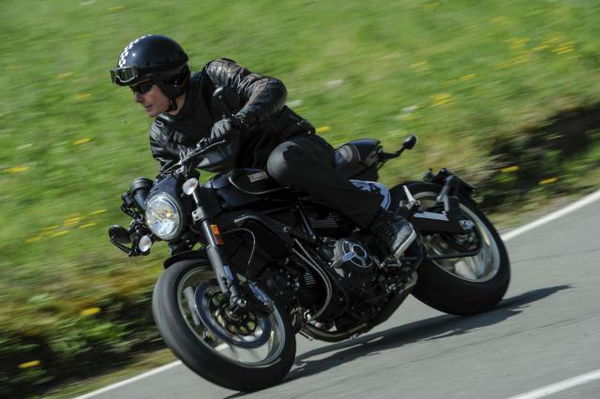
Suspension
And this may be key to the Street Cup’s retention of comparatively good handling despite its weight disadvantage: it’s better suspended than the Ducati.
The Scrambler Café Racer feels bouncy, scrambler-ish. With its more enthusiastic throttle response, it feels more seesaw-like in traffic.
The Street Cup feels a more composed, solid platform, while offering just as much comfort as the Ducati.
Both bikes have KYB suspension at either end, pre-load adjustable at the rear and non-adjustable at the front. The Triumph has twin shocks and right-way-up fork while the Ducati goes for mono-shock and upside-down fork.
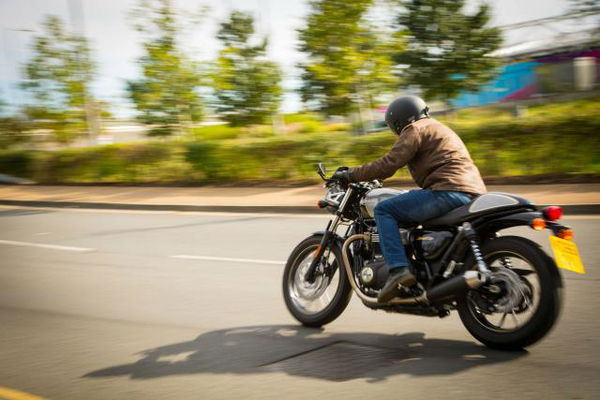
Brakes
Both bikes have a single front disc (why not two?) offering less than colossal stopping force. The Ducati’s should be stronger. It’s the biggest by 20mm, at 330mm, and has a radial-mounted monobloc Brembo M4-32 four-piston caliper, compared to the Street Cup’s two-piston Nissin.
But the Scrambler Café Racer’s front brake isn’t stronger. There’s good initial but it doesn’t seem to progress quickly enough as you squeeze further, so you feel the need of more – and have to squeeze harder still for it – when something unexpected happens.
The Street Cup’s is more predictable. Squeeze it and it slows you down; squeeze it more and it slows you down more, offering stopping force in proportion the force you apply. You know, like brakes are supposed to.
Maybe the Scrambler Café Racer we rode needed bleeding. I don’t recall having the same complaint about other variants of the Ducati Scrambler.
Equipment
The Scrambler Café Racer’s dash has a rev-counter, trip meters, low-fuel warning light and… wait a minute… Nope, that’s it. Apart from the obligatory speedometer and odometer of course.
There’s no fuel gauge, let alone a fuel consumption meter.
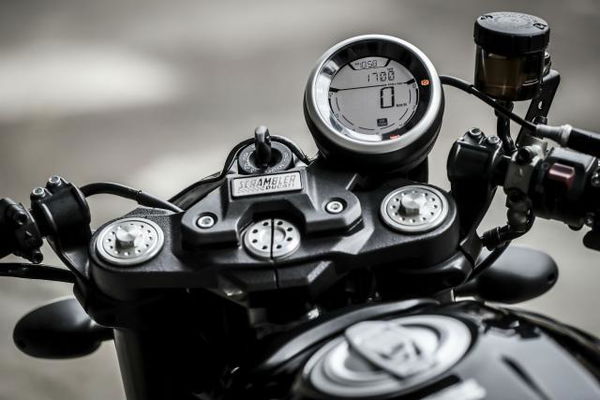
The Triumph has a fuel-gauge, fuel-consumption meter and range to empty, and its analogue clocks with chrome surround are nicer to look at than the Ducati’s single LED one.

The Triumph also has traction control, while the Ducati does not.
Both of course have ABS.
They both also get a very handy, if not very traditional, USB charging socket under the seat.
The both get essential café racer features, including pillion seat covers and lower bars than the models from which they are derived (the Ducati’s being clip-ons while the Triumph’s are the ‘swallow-tail’-type).
The Triumph has a fly screen offering a small degree of wind-deflection at speed, while the Scrambler Café Racer just gets a plastic cover around the headlight unit and back of the clock.
So the Street Cup wins in the equipment department.
We like
The agility and ease-of-use of the Ducati and the proper traditional feel and styling of the Triumph.
We don’t like
Have you seen the price of the Ducati? It’s £9,395, compared to £8,800 for the Triumph.
We took a not-very-scientific random sample of opinions on the two bikes at the Distinguished Gentleman’s Ride and someone pointed out that, in performance terms, the Scrambler Café Racer is probably not a world away from the humble Suzuki SV650, which can be picked up for a bit over five grand.
Okay, so buyers of the Ducati may not be interested in the Suzuki, because they want café racer styling – but £4,000 is a big premium to be charged for that privilege.
It’s £1,845 more than the base-model Scrambler Icon. Of course, you don’t get twin stacked Termignoni exhausts with the Icon but do they actually suit the Scrambler Café Racer? We found the styling of the Ducati divided opinion too. One person said it looked like a 'Scrambler that's taken a 10-minute dash through Claire's Accessories'. Others loved it, to be fair.
No one expressed disapproval for the Triumph's styling.
Personally, I don’t like the Street Cup's black plastic tail light unit. It just doesn’t go with the rest of the bike, as if the designers had given up by the time they got round to it.
And it would benefit from spoked wheels. The Scrambler Café Racer doesn’t have these either but it doesn’t seem to be aiming for quite the same degree of tradition in its look – its more tradition meets future – and so it gets away with it better.
CLICK NEXT FOR VERDICT AND SPECS.
…And that is the problem for the Scrambler Café Racer: it’s not as traditional. Looking around at the Distinguished Gentleman’s Ride, the Triumph just meets the brief better.
It might seem perverse to penalise the Scrambler Café Racer for not being technically all that much better than a humble SV650, while not accusing the Street Cup of similar crimes – but the Triumph achieves something else besides.
It’s more traditional to ride, with its wrong-way-round torque and power figures. It’s more traditional to look at, with its (fake) cooling fins, twin shocks and dial clocks.
If you want a new-rider-friendly, reasonably powerful V-twin, that’s a café racer by name and a modern interpretation of one by style, then you’ll get on well with the Ducati. It’s a great town bike, for example.
If you want a bike that actually looks and feels like a traditional café racer, then save yourself £600 and get the Triumph.
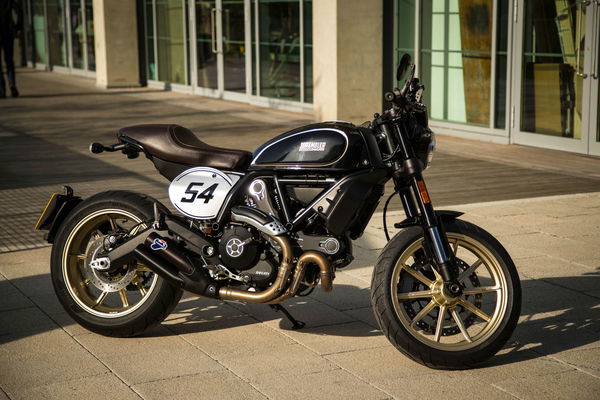
Model tested: 2017 Ducati Scrambler Café Racer
Price: £9,395
Engine: 803ccc V-twin
Power: 73hp @8,250rpm
Torque: 49lbft @5,750rpm
Wet weight: 188kg (dry 172kg)
Tank capacity: 13.5 litres
Seat height: 805mm
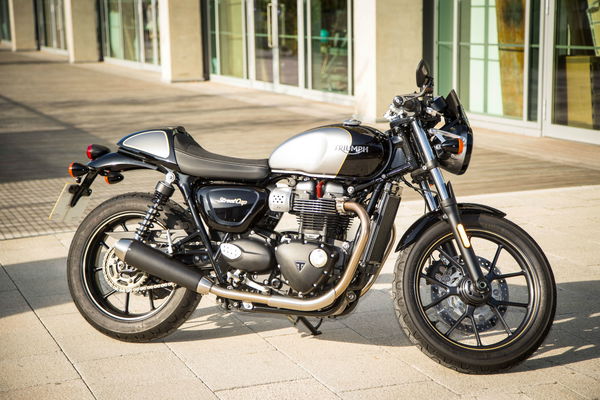
Model tested: Triumph Street Cup
Price: £8,800
Engine: 900cc liquid-cooled parallel-twin
Power: 55hp @5,900rpm
Torque: 59lbft @3,230rpm
Dry weight: 200kg
Tank capacity: 12 litres
Seat height: 780mm
READ OUT FIRST REVIEW OF THE TRIUMPH STREET CUP HERE AND DUCATI SCRAMBLER CAFE RACER HERE.
